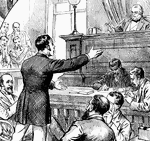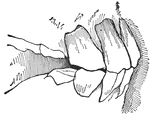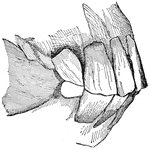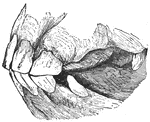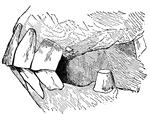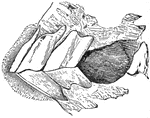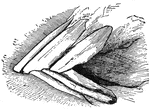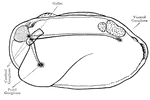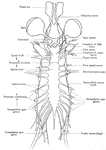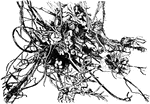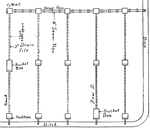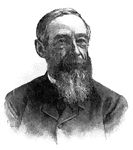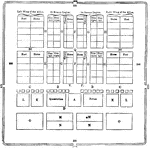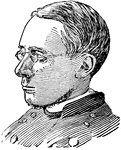
Morgan Dix
(1827-1908) American author that wrote works such as Commentaries on Romans and on Galatians and Colossians;…
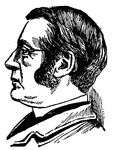
Charles W. Eliot
(1834-1926) Educator who became president of Harvard and presided over a period of great growth which…
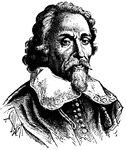
William Harvey
(1578-1657) English physician who published his treatise on the circulatory system in 1628.

Trombone A Piston
This is a tenor trombone having instead of the slide a system of pistons, like those of the horn and…
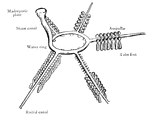
Starfish
The common starfish is a five rayed star. The central body is called the disk and the arms are the rays.…

Digestive system
Digestive system of a mammal. (g) gullet; (s) stomach; (sm) small intestine; (lm) large intestine; (r)…
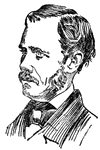
John A. Dahlgren
Dahlgren was a naval officer and inventor. He invented the Dahlgren gun and wrote many books.

System of Arc Lights
The System of Arc Lights is a device used to obtain electric light by conducting a current of electricity…

System of Incandescent Lights
The System of Incandescent Lights is a device in which electric light is obtained by conducting a current…

Blood Circulation
The blood is made to circulate within the system of closed tubes in which it is contained by means of…
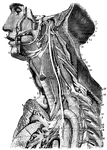
Human Nerve System
Diagram of the upper half of a male human showing the routes of the nervous system.
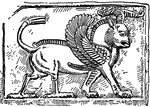
Assyrian Relief Sculpture
The griffin, a monster with a lion's or panther's body and the head and wings of an eagle, played an…

Savannah, Georgia, Looking East
"View of Savannah, Ga., looking east, toward Fort Jackson. Savannah, the entry port of Georgia, is built…

Catapult
"Catapult from the Roman military system. The Roman army was divided into legions, each of which contained…

Martin Luther
"Martin Luther was born at Eisleben in 1483. He was the son of a poor miner, had entered the Augustinian…
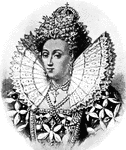
Queen Elizabeth
"Queen Elizabeth was the daughter of Henry VIII, by Anne Boleyn. Her reign is one of the most remarkable…

Alimentary Canal
"The digestive sac, tract, or tube of any animal; the visceral or intestinal cavity."-Whitney, 1902
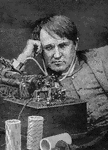
Thomas Alva Edison
"Thomas Alva Edison was born at Milan, Ohio, February 11, 1847, but the family soon after moved to Port…

Block and Tackle
"A Block is a pulley or a system of pulleys rotating on a pintle mounted in its frame or shell with…
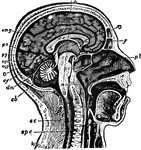
Human Brain
"The Brain is the encephalon, or center of the nervous system and the seat of consciousness and volition…
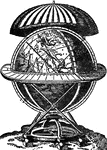
Globe of Copernicus
"Copernicus, or Nicholas Koppernigk, was the founder of modern astronomy. From a school in Thorn Copernicus…

Maxim’s Flying Machine
"A Flying Machine is a device for enabling man to navigate the air. The feat of flying has been often…

Wireless Telegraph Transmitter
"Wireless Telegraphy is a system of transmitting messages between distant points without the use of…
Wireless Telegraph Receiver
"Wireless Telegraphy is a system of transmitting messages between distant points without the use of…
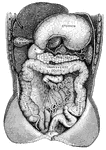
Digestive system
"Showing the Relations of the Stomach, Liver, Intestines, Spleen, and other Organs of the Abdomen. Aduodenum;…

Nervous System
"Diagram illustrating the General Arrangement of the Nervous System. (posterior view.)" — Blaisedell,…
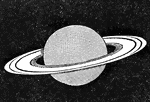
Saturn
"Saturn is the 6th of the major planets in order of distance from the sun, and the outermost known to…
Tapeworm
"The Tapeworm is an intestinal worm, Tænia solium, in form somewhat resembling tape. Its length…
!["The Tapeworm is an intestinal worm, Tænia solium, in form somewhat resembling tape. Its length is from 5 to 15 yards, and its breadth from two lines at the narrowest part to four or five at the other or broader extremity. At the narrow end is the head, which is terminated anteriorly by a central rostellum, surrounded by a crown of small recurved hooks, and behind them four suctorial depressions; then follow an immense number of segments, each full of microscopic ova. The segments are capable of being detached when mature, and reproducing the parasite. There is no mouth; but nutrition appears to take place through the tissues of the animal, as algæ derive nourishment from the sea water in which they float. The digestive system consists of two tubes or lateral canals, extending from the anterior to the posterior end of the body, and a transverse canal at the summit of each joint. [Pictured] A single segment or proglottis magnified; 1, generating pore; 2, water vessels; 3, dendritic ovary."—(Charles Leonard-Stuart, 1911)](https://etc.usf.edu/clipart/16500/16595/tapeworm2_16595_mth.gif)
Tapeworm
"The Tapeworm is an intestinal worm, Tænia solium, in form somewhat resembling tape. Its length…
!["The Tapeworm is an intestinal worm, Tænia solium, in form somewhat resembling tape. Its length is from 5 to 15 yards, and its breadth from two lines at the narrowest part to four or five at the other or broader extremity. At the narrow end is the head, which is terminated anteriorly by a central rostellum, surrounded by a crown of small recurved hooks, and behind them four suctorial depressions; then follow an immense number of segments, each full of microscopic ova. The segments are capable of being detached when mature, and reproducing the parasite. There is no mouth; but nutrition appears to take place through the tissues of the animal, as algæ derive nourishment from the sea water in which they float. The digestive system consists of two tubes or lateral canals, extending from the anterior to the posterior end of the body, and a transverse canal at the summit of each joint. [Pictured] Head of tænia solium (enlarged)."—(Charles Leonard-Stuart, 1911)](https://etc.usf.edu/clipart/16500/16599/tapeworm3_16599_mth.gif)
Tapeworm
"The Tapeworm is an intestinal worm, Tænia solium, in form somewhat resembling tape. Its length…
